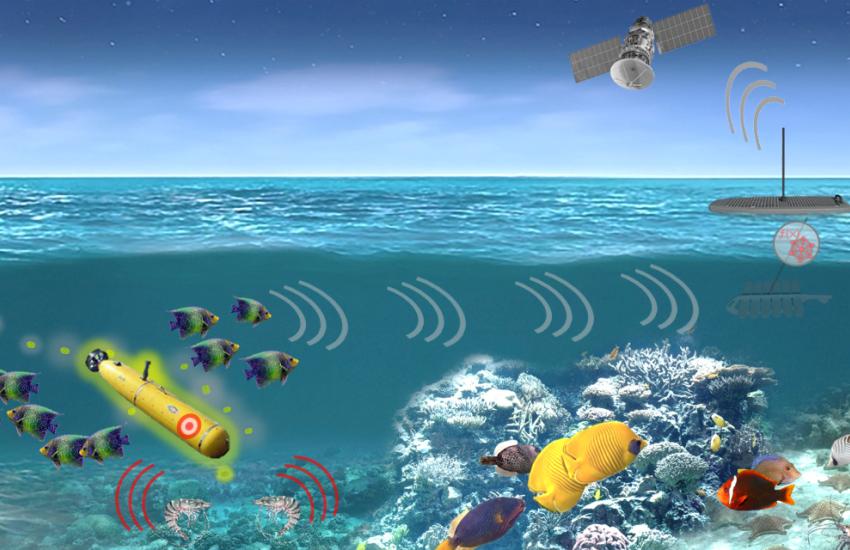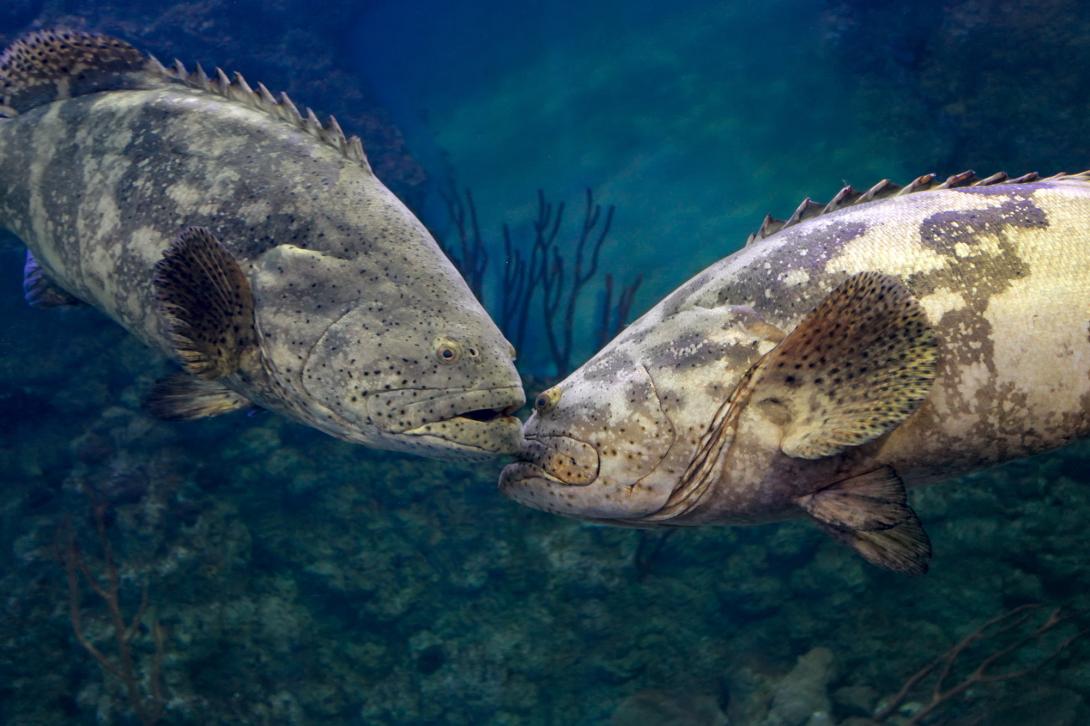Navy Eavesdrops on Talking Fish for Maritime Security
The U.S. Naval Sea Systems Command’s Surface Warfare Center has accepted technology that monitors communications between fish to identify maritime threats such as manned or unmanned submarines and may adopt a somewhat similar system following final tests this summer.
Under a Defense Advanced Research Projects Agency (DARPA) program known as Persistent Aquatic Living Sensors (PALS), a team led by Florida Atlantic University has developed a system to monitor the communications among goliath grouper. That system now rests off the coast of Florida and serves as a threat sensor for national security and defense.
“We accepted the hardware, and it’s actually deployed right now. You can go see it off the bridge in Panama City Beach, in Saint Andrews Bay. Most of what we’re doing is just really eavesdropping on the marine biology,” explained Cameron Matthews, chief scientist for counter-unmanned undersea technologies at the Surface Warfare Center.
Initiated in 2018, DARPA’s PALS program is scheduled to end this summer when a Northrop Grumman team completes its final demonstration. The team is developing biological sensing hardware that has “increased sensitivity for certain sensor modalities, achieving greater range,” according to a 2019 company press release. Artificial intelligence will be applied to observe patterns in the marine environment to help classify targets. Northrop Grumman partnered with Coda Octopus; Duke University; University of Maryland, Baltimore County; and the University of Memphis.
“The detection, classification and tracking of undersea objects is a critical military capability and we are excited to work with DARPA to develop this next-generation approach,” Mike Meaney, Northrop’s vice president for advanced systems, said in the release.
Northrop chose to monitor snapping shrimp. The company, due to no fault of its own, will be the final team to complete the program, according to Tiffany Prest, DARPA’s PALS program manager. “There have been some particular limitations to timing of technology testing. Of course, you’re always combating seasonality and system upgrades and supply chains and really just trying to make sure that we’re enhancing the performance of the technology to its best capacity. It’s not really just one reason. It’s, like, a conglomeration of many reasons.”
While some people may not realize that fish and other marine organisms communicate, some can be a little chatty, according to Matthews, who holds a degree in fish languages. “Nine out of 10 fish in the sea have a language pretty much on average. How much they talk to other fish is debatable, but they’re obviously listening to each other when they talk.”
For example, goliath grouper, so named because they can grow up to 700 pounds, make a boom sound under some circumstances. They generate characteristic low-frequency sounds when they mate as well as when they are approached by divers, possibly due to distress. The “boom” sounds are acoustically distinct from other species of groupers. Also, goliath groupers tend to be curious and inspect novel objects encroaching on their habitat, Florida Atlantic University explained in a press release.
“This behavior, combined with the fact that other groupers have been shown to use acoustic communication to display agonistic behavior, suggests that goliath grouper produce vocalization booms in response to threats that are discernible from vocalizations for other purposes such as attracting mates,” Laurent Chérubin, principal investigator and an associate research professor at the university’s Harbor Branch, said in the release.
While goliath groupers go boom, boom, boom, snapping shrimp—as the name implies—prefer a little snap, snap, snap. Just a couple of centimeters long, they snap with one claw that can be half the size of their body. They close the claw at a speed of about 60 miles an hour, forming a bubble that then bursts, creating a loud snap that can achieve more than 200 decibels.
While sea creatures may be surprisingly noisy, Matthews noted that fish are not as adept at language as mammals. “Statistically, not every fish talks, but by far and away, most of the ones that have been studied were found to have some form of communication capability. And a lot of these fish are hardwired actually for communication, so the brain is essentially preprogrammed,” he said. “Mammals can change and adapt to language. Fish, they kind of have to work with the basic building blocks they were given.”
According to DARPA’s website, PALS technology aims to augment the Department of Defense’s existing, hardware-based maritime monitoring capabilities and detect, characterize and report the presence of manned or unmanned underwater vehicles ranging from small autonomous vessels to large nuclear submarines. Because marine organisms are ubiquitous in their environments, self-replicating and largely self-sustaining, sensing systems that use marine organisms as their foundation would be discreet and cost-effective and provide persistent undersea surveillance with a minimal logistical footprint.
The site adds that the envisioned PALS system would work in two stages. First, marine organisms sense the presence of an underwater vehicle and respond with a signal or other observable behavior. Then, a man-made detector system observes, records and interprets the organisms’ response and transmits analyzed results to remote users as distilled alerts. The complete PALS system would also discriminate between target vehicles and other sources of stimuli, such as debris and other marine organisms, to limit the number of false positives. By teaming marine organisms with distributed detection systems, PALS aims to greatly extend the lifetime and range of undersea surveillance capabilities.
The broad agency announcement issued in 2018 states that teams must meet several criteria in an uncontrolled marine environment during the third and final phase, including detection out to 500 meters while “handling more confounding targets” and 60-day endurance while taking measurements every 30 minutes.
“This was really thinking about homeland security and being able to tap into what already exists in nature, specifically thinking about marine organisms in more coastal areas and their innate abilities to sense and respond to perturbations that occur in their environment,” Prest said. “Dogs sense and respond to their environment. People sense and respond to their environment. All organisms sense and respond to their environment, so that’s what this particular program is really trying to leverage.”

While the system is designed primarily for littoral or shallow waters, Matthews suggested it may be useful anywhere monitoring is needed. “I think it’s safe to say the PALS technologies could be considered for use in any water space where biologicals frequent, so virtually all of them require monitoring for threats. There’s fish everywhere, from the shallowest of shallow all the way down to the bottom of the ocean.”
Asked what the program’s biggest challenge might have been, Prest pointed to Mother Nature herself. “Biology is messy. That is an evergreen challenge for any system, any technology, any idea that’s leveraging biology. Unsurprisingly, that has also been a challenge within this particular program, the fact that we’re working with living organisms that have minds of their own that sense and respond to many different things. Finding something meaningful out of all of that information can sometimes be complicated.”
Prest also pointed out that the program causes no harm to any marine organisms. DARPA specifically chose solutions that monitor the different species from a distance. Additionally, the broad agency announcement stipulated that technology solutions involving marine mammals would be rejected.
For sensitivity reasons, the program manager declined to provide statistics or other details, such as exactly how far away the sensors could be from the creatures being monitored, the success rate in reducing false positives or how exactly booms and snaps get translated into “Nuclear submarine!” But she indicated the program has successfully achieved its goals. “If you’re asking whether or not I think that the program has been successful, I would say, ‘Yes,’ I do believe that we have proved that using biology has merit and that this particular concept has merit.”
Matthews echoed the point a bit more emphatically. “The PALS system represents a completely new approach to monitoring threat systems. Watching the biological systems in the water space, we’re able to focus on a readily quantifiable and easily accessible warning system. Not to mention that it’s self-sustaining. And we can watch for extended periods of time to build up confidence and drive down the risk of false positive detections. It’s a wildly radical departure from conventional threat detection systems, particularly below the waterline.”
Regarding the rather obvious Aquaman comparison, Matthews offered a more muted response. “I’m sure a lot of people in my line of work—and there aren’t that many—would love to achieve that capability. We’re not there yet that I’m aware of.”




Comments